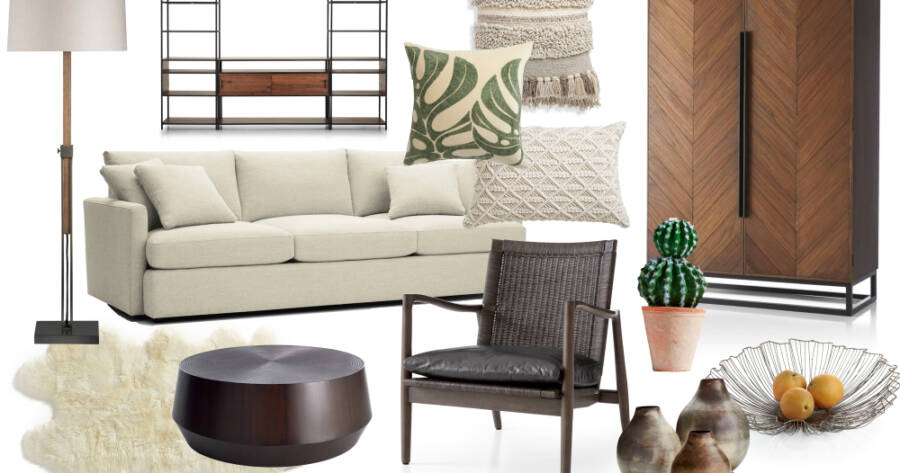Designing a room is an exciting process, but it can also feel overwhelming when you’re faced with endless possibilities. A mood board helps bring your vision to life by gathering all your design ideas in one place. Whether you prefer to pin images on Pinterest, create a physical collage with printed photos, or use a simple binder to organize inspiration, a mood board is the perfect tool to stay focused and inspired as you transform your space.
What is a Mood Board and Why Is It Helpful?
A mood board is a visual tool used to organize and communicate your design ideas for a space. By gathering images, colors, textures, and materials that resonate with your vision, a mood board helps you clarify your preferences and ensure cohesion throughout the room.
Essentially, it serves as a reference point as you make decisions on furniture, colors, and decor, making it easier to see how different elements come together before committing to your design. Mood boards are invaluable for staying focused and inspired during the design process.
Using Pinterest to Gather Inspiration
Pinterest is one of the best platforms for gathering and organizing design inspiration. Simply create a board dedicated to your room design, then start pinning images that inspire you. Whether it’s furniture, color palettes, or room layouts, Pinterest gives you access to endless design ideas.
You can search by themes, styles, or specific items, making it easy to build a vision board tailored to your preferences. Over time, you’ll start noticing patterns in your pins, which will help guide your design decisions and refine your style.
Print and Create a Collage on a Cork Board or Poster Paper
If you prefer a hands-on approach, printing out photos and creating a physical mood board is a fantastic DIY option. Choose images from magazines, online sources, or your Pinterest board, and print them in various sizes. Then, arrange and attach the images to a corkboard or large poster paper.
This tactile method allows you to physically move the images around, helping you visualize how different elements interact. It’s a great way to see your design choices in real life and get an instant visual feel for your room.
Creating a Design Binder with Printed Ideas and Textiles
Another practical way to organize your ideas is by creating a design binder. Simply print out your favorite photos, color swatches, and design concepts, and organize them in a three-ring binder with dividers for each category (e.g., furniture, wall colors, textiles). You can also consider adding textiles like fabric or flooring samples to help bring the vision together.
This method allows you to keep your inspiration tidy and easily accessible. You can flip through the binder to compare different options, ensuring that you’re making informed decisions. A design binder is portable and perfect for anyone who likes to keep their ideas organized in one place.
Using Canva to Design a Digital Mood Board
For a more polished and digital approach, Canva is a fantastic tool for creating a mood board. With Canva’s easy-to-use platform, you can upload your inspiration photos and arrange them into a cohesive layout. Canva even offers a drag-and-drop functionality, making it simple to resize, rotate, and organize images. They also offer templates to help you get started.
You can also experiment with color schemes and text to add annotations or notes. Once you’re satisfied with the layout, you can download and print your digital mood board or keep it on your device for easy reference during the design process.
Incorporating Color Palettes Into Your Mood Board
Color plays a crucial role in setting the mood of a room, and a mood board is the perfect place to experiment with different color palettes. Whether you’re using a digital tool like Canva or a physical board, start by selecting colors that evoke the feeling you want for the space.
You can consider incorporating paint swatches, fabric samples, or color photographs to help visualize how the colors interact. Having a color palette on your mood board ensures that your room design remains cohesive and visually appealing, making it easier to choose wall paints, upholstery, and accessories.
Adding Textures and Patterns to Your Mood Board
Textures and patterns add depth and interest to any room design, so it’s important to include them on your mood board. Use fabric swatches, pictures of textured surfaces, or even printed patterns to help you visualize how different materials will look in your space.
This can include wood finishes, textiles, or rugs. Whether you’re drawn to minimalist, rustic, or eclectic looks, adding these elements to your mood board allows you to experiment with various combinations to ensure that everything harmonizes within the room.
Refining Your Mood Board as You Go
As you dive deeper into your room design, remember that your mood board is a flexible tool that can evolve. Initially, your board might be filled with diverse ideas, but over time, you’ll start narrowing down your choices as you refine your style.
Also, don’t be afraid to replace images, swap out colors, or add new ideas as they come to you. The goal is for your mood board to act as a dynamic, visual reference that helps guide you through the decision-making process and ultimately results in a room that reflects your vision.
Bringing Your Vision to Life
Creating a mood board is an enjoyable and essential step in the room design process, allowing you to visually bring your ideas to life.
Whether you choose to go digital with tools like Canva or stick with a hands-on approach using a corkboard or binder, the key is organizing your inspiration in a way that makes sense for you. As you refine your vision and make decisions, your mood board will guide and inspire you, ensuring that your space truly reflects your personal style.

